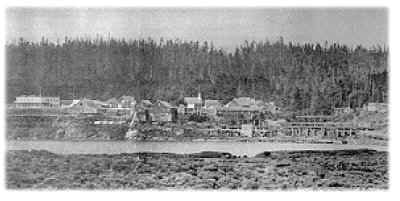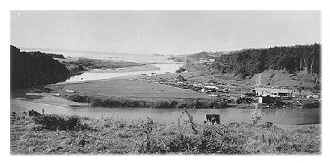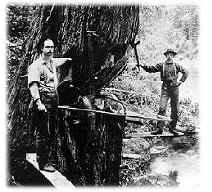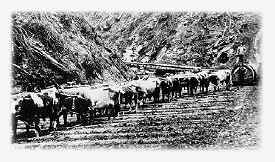


Town of Gualala 1903-1905
There are several different versions of where the name Gualala came from. The Pomo indians who lived in the area gave the Gualala River a name that meant "water coming down place." The town took its name from the river. The word the Pomos used was very similar to the present day pronunciation of Gualala. People from many different parts of the world came to this area to work and live. They each gave the name their own variation of spelling and pronunciation.
General Rafael Gracie was given a land grant extending from the Gualala river
north to Mal Paso creek. This land grant was for about 62.5 square miles. He
used the land for grazing cattle & later sold the land for $10,000. This was
probably a smart move because his grant was eventually deemed invalid by the
courts. Even before the final court decision homesteaders began moving to the
area. Most of them were farmers. In about 1861, a man named Cyrus Robinson & his
wife Elizabeth filed a homestead for all of the area which is now Gualala. They
built and owned a hotel, a saloon and a ferry in Gualala. They also supervised
the Post Office (which was also the stage stop), the Wells Fargo Express and the
Western Union. Within a year they sold part of their land to the men who would
build the first lumber mill in Gualala. This mill was
 located at the mouth of Mill Gulch, now known as China Gulch. About 1871, the
Mill Company started a company store. This store (which was still operating) and
the warehouse, water tower and stairs down to the river burned to the ground in
the mid 1960's.
located at the mouth of Mill Gulch, now known as China Gulch. About 1871, the
Mill Company started a company store. This store (which was still operating) and
the warehouse, water tower and stairs down to the river burned to the ground in
the mid 1960's.
Whenever the Robinson's sold land in Gualala they put a stipulation in the contract that the new owner agree not to permit any hotel or bar on the land. From the 1860's on, tourists have been coming to Gualala. They came to hunt, to get away from the crowded cities and relax, to enjoy an area where flowers are blooming all year, to fish for steelhead or salmon and to dive for abalone. In the late 1800;s Gualala was a major commercial hub for the entire area. People came from miles away to sell what they had produced and buy supplies. By 1895 there was a dancing school. the Gualala Municipal Brass Band and an Opera House in Gualala. Elizabeth Robinson died in 1902 and the Gualala House, their hotel, burned to the ground in 1903. The Gualala Hotel was then built a few blocks south of where the Gualala House had been. It cost $6,000 to build. The Gualala Hotel used to include a barn, a woodshed, a dairy and a huge garden. In 1907, Mark Pedotti and Antonio Ciapusci bought the Gualala Hotel property which included 636 acres. They also had bought the Tait ranch. They eventually divided the properties - Mark took the ranch and Antonio took Gualala. When Antonio died in 1932, the Hotel and the Gualala property was taken by his son George and wife, Ida. When the Gualala Hotel was sold in 1945 it was still using a diesel power plant to operate because there wasn't any electric power in Gualala until 1952.
There weren't any schools in the area until 1883. Until that time it was a common custom to send children to live with other families in larger areas to attend school.
The lumber mill in Gualala burned to the ground on September 14, 1906. Less than 2 months later Cyrus Robinson died. In about 1865 Robinson's put in an apron chute at Robinson's Landing for getting cargo to & from the schooners, but he chose a bad location. Soon after another man named Morton Bourn started his own landing 2 1/2 miles north but in a much better protected location for the ships. Before long the mill purchased land from Morton Bourn for the purpose of extending their railroad from the Robinson's landing to Bourn's landing. The mill had to make 2 moorings - one for themselves and one for the Bourn's. The one for the Bourn's was used for commercial purposes.
In the early days it took 2 days to travel the 40 miles from Jenner to Gualala. By 1877 a railroad line had been built connecting Duncan's Mill to Sausalito. From Sausalito passengers could take a ferry to San Francisco. Because of this railroad, daily stage service was started between Mendocino & Fort Ross on the coast and between Fort Ross & Cazadero. From Cazadero passengers took a narrow-gauge railroad to Duncan's Mill. This meant that a passenger could travel from Gualala to San Francisco in one long day. In 1892 the first bridge was built across the Gualala river. At that time the ferry went out of business except for when high water or some other problem put the bridge out of commission temporarily. In 1906, the bridge fell down during the earthquake. The bridge was repaired and lasted until 1919 when it collapsed for the last time. It was replaced with a steel bridge which lasted for 40 years. In 1958 a new bridge was built across the Gualala river.
About 1920 Mendocino county started a new coastal road. The road construction that began about this time was because of the automobile. Clear into the 1940's there weren't many autos in this area. Highway 1 was still a dirt road with 18 gates that had to be opened and shut between Jenner and Gualala. Horses were still used extensively. The cars couldn't make it through the mud during the winter or the up the steep grades. By 1940 the state of California had taken over the coastal highway.
Redwood trees presented some new & interesting problems to the loggers. The
trunk of a redwood is larger, tougher & less desirable near the ground than a
little higher up. The obvious answer was to cut the tree higher up. This is why
so many high stumps are found in this area. In the beginning they
 used scaffolds to raise the fallers up to where they avoided the problems with
the base of the trunk. Next came the springboards which were
wedged into the sides of the trunk and provided a place for the faller to stand.
New tools were invented to work with the redwoods. People began arriving from
all over the world to take jobs created by the logging industry. Lumber was in
great demand at this time. After the trees were felled, preferably uphill or
into the river so the soft redwood wouldn't split, a bucker
cut off the limbs and cut the trunk into lengths for the mill. Then a peeler
went to work getting the bark off of the logs. The loggers planned their work
with the seasons so that the sap would be running in the trees at the time they
were cut. This made the peeler's
job much easier. Taking the bark off in the woods made it much easier to
pull the tree along the wood lined skid road to the mill. There was also a
sniper who rounded one end of
used scaffolds to raise the fallers up to where they avoided the problems with
the base of the trunk. Next came the springboards which were
wedged into the sides of the trunk and provided a place for the faller to stand.
New tools were invented to work with the redwoods. People began arriving from
all over the world to take jobs created by the logging industry. Lumber was in
great demand at this time. After the trees were felled, preferably uphill or
into the river so the soft redwood wouldn't split, a bucker
cut off the limbs and cut the trunk into lengths for the mill. Then a peeler
went to work getting the bark off of the logs. The loggers planned their work
with the seasons so that the sap would be running in the trees at the time they
were cut. This made the peeler's
job much easier. Taking the bark off in the woods made it much easier to
pull the tree along the wood lined skid road to the mill. There was also a
sniper who rounded one end of
 the
log so it wouldn't dig in as it was pulled. In the early days the logs were
pulled by teams of oxen. Several logs were chained together
with a hollowed out log at the end to haul equipment & supplied back & forth. A
water-slinger ran ahead of the oxen. His job was to keep the wooden skids
wet so the logs would slide over them easier. Eventually the oxen were replaced
by the donkey engine which could deliver logs to a landing and then either to
the river to be floated downstream to the mill or onto railroad cars for
transportation to the mill. The railroads were for delivering logs to the mill
and lumber to the port for shipping. Logging camps sprang up all along the
Gualala River and its tributaries. When a camp was ready to move to a new
location they just took the buildings apart, moved the materials to the new
location and reassembled them. The early loggers cut everything. All different
sizes of trees could be used for something. The last lumber mill in Gualala
closed in 1970. Trees are still harvested in the area, but they are trucked to
other mills north of here.
the
log so it wouldn't dig in as it was pulled. In the early days the logs were
pulled by teams of oxen. Several logs were chained together
with a hollowed out log at the end to haul equipment & supplied back & forth. A
water-slinger ran ahead of the oxen. His job was to keep the wooden skids
wet so the logs would slide over them easier. Eventually the oxen were replaced
by the donkey engine which could deliver logs to a landing and then either to
the river to be floated downstream to the mill or onto railroad cars for
transportation to the mill. The railroads were for delivering logs to the mill
and lumber to the port for shipping. Logging camps sprang up all along the
Gualala River and its tributaries. When a camp was ready to move to a new
location they just took the buildings apart, moved the materials to the new
location and reassembled them. The early loggers cut everything. All different
sizes of trees could be used for something. The last lumber mill in Gualala
closed in 1970. Trees are still harvested in the area, but they are trucked to
other mills north of here.
Another very large enterprise that flourished for years on the coast was tanoak bark. This is because of the tannic acid used in tanning leather. Nobody had any interest in the wood, just the bark. This was a business that a small family could work at, but it was also big business. The peeler's job started in March or April and lasted until July, August or September. It all depended on the sap in the trees. The major players in this industry continued until about 1920, however some individuals continued until the 1950's.